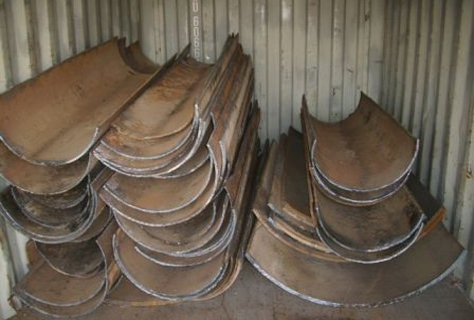
Mostly in Asian economies which are still emerging industrial nations, there exists a house-hold industry or many small scale industries who re-use scrap in order to produce a low market finished product suitable for the secondary sector. One such industry is re-rolling of scrap steel. Depending on the weight and size of an individual piece of scrap metal, re-rolling is done to produce a finished product. In the Indian Sub-continent, ship breaking and demolition scrap is the main source of re-rollable scrap. However, DS Metals, as we come across these grades of scrap metal across the world, we also supply them to our users/buyers for re-rolling.
The various types of re-rollable scrap, that DS Metals sells are described below.
A. Premium Grade : This material comprises of Re-bars of thickness ranging from 25 mm to 40 mm. The length varies from minimum one meter to 19 feet. Weight of each piece ranges from 5 kg upwards.
B. Normal Grade : This material comprises of Re-bars of thickness ranging from 16 mm (minimum) to 24 mm (maximum). The length varies from minimum one meter to 19 feet.
A. Premium Grade (NORL) : This mainly comprises of plates, H-beams, I-beams, angles, channels, etc. with minimum thickness of 12 mm and above. The length varies from minimum one meter to 19 feet.
B. Normal Grade (YARL) : This mainly comprises of plates, H-beams, I-beams, angles, channels, etc. with minimum thickness of 8 mm to 12 mm. The length varies from minimum one meter to 19 feet.
Cobble is a term used in the industry to describe the lowest form (and usually the cheapest) of hot rolled steel plates. The steel that does not make through the entire plate finishing process in a mill, yields a cobble plate. Reasons for failure can vary from not meeting desired thickness; variation in width; ovality in shape; length beyond tolerances and un-desirable chemical composition. Signs of cobble are usually un-finished (rolled) edges; varying type of surface conditions (pitting, scaling, rusting) etc. Thickness of these cobble plates / plate ends varies from 6mm to 60mm. Such material is sourced from large plate manufacturers in industrialized economies.




This kind of scrap is generated from cutting of large dia pipes used in the oil industry. These pipes are cut semi-circularly (commercially known as “moon-cuts”) for re-rolling. These pipes can be straight welded or spiral welded and the wall thickness must be of minimum 8mm with no limit on the maximum. When moon-cut, the length of each piece can be up to a container length, but a minimum of 1 meter.




Billets, heated during a rolling process in a rolling mill, generate normal rejections which are termed as mis-rolls. When a billet passes through rolls for thickness reduction and it falls off the production line, it is scrapped for re-use. These are generally available from large steel mills and re-rolling mills. Length/thickness of these billet end cuts/mis-rolls varies.